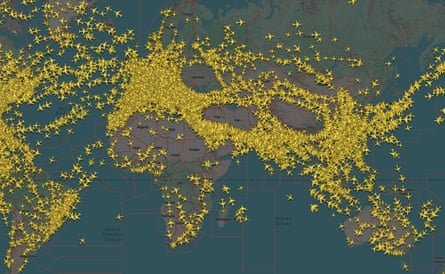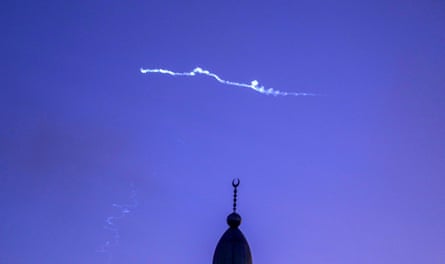The first indication that something was wrong came when the clock on the flight deck began to go backwards. The aircraft was cruising thousands of metres above Israel and as the crew noticed the error, they checked their GPS signal. The plane’s internal instruments showed it was flying at just 1,500ft, well below the cruising altitude of 38,000ft it should have been at.
Seconds later, alarms began to sound and lights flashed throughout the cockpit.
“Our terrain avoidance system sprang into action, warning us that we were heading for a collision with the mountainous terrain,” the plane’s pilot says. Over years of flying, it had been drilled into the crew to pull back on the controls when such an alarm sounded, but on this occasion the pilot took no action.
The crew were prepared for their system to make “spurious” warnings and knew from experience they were still flying at a safe altitude.
The pilot involved – who works on long-haul routes for a UK airline – said they had experienced GPS spoofing, one in a catalogue of growing risks facing airlines as they traverse a world in which warfare has become newly normalised amid a fracturing of global diplomacy.
Speaking to the Guardian on condition of anonymity, the pilot called the incident last year unsettling, but stressed the flight was never at risk. However, they expressed concern that such an event only makes pilots more desensitised to the internal systems they have relied upon for decades.
“You are meant to feel uncomfortable in your inaction and that is exactly how I felt.”
Flying through conflicts
Since Russia’s fullscale invasion of Ukraine in 2022, the world has seen a surge in state-based conflicts. By some measures, the proportion of the world engulfed by warfare has grown 65% since 2021– an area equivalent to nearly double the size of India – with new and reemerging hotspots in Ukraine, the Middle East, Myanmar and central Africa.
As the paths through safe airspace distort and narrow, airlines have been forced to divert flights around conflict zones and geopolitical hotspots, while cancelling some routes altogether.
Most western airlines are now banned from flying over Russia, forcing them to fly longer routes, extending flight times and pushing up costs. As a result, last year British Airways and Virgin Atlantic axed their direct flights between London and Beijing.

For other airlines, diverting routes through the Middle East to avoid Russian airspace only supplanted the risks, as conflict spreads across the region and pilots find themselves sharing the skies with barrages of drones and missiles – some of which have reportedly come close enough to be seen by pilots and passengers.
Sudden outbreaks of conflict – as seen earlier this month when tensions between Israel and Iran erupted into open warfare – have forced airlines to respond rapidly. On Monday, as Iran launched a retaliatory barrage of missiles at a US base in Qatar, two dozen flights were forced to divert away from one of the world’s busiest hubs, between Dubai and Doha.
The incident demonstrated how the effects of unexpected strikes and airspace closures can reverberate across the world: Qantas was forced to divert two flights in mid-air, while Air India said it would suspend all flights to eastern North America and Europe due to the increasingly narrow path between those destinations and the Indian subcontinent. Hundreds more flights were cancelled altogether.
The re-routings are placing a bigger burden on airlines’ bottom lines – and on the environment.
As one example, flights between Helsinki and Tokyo now take up to three and a half hours longer than before the war in Ukraine began, says Viktoriia Ivannikova, assistant professor in aviation management at Dublin City University.
“If you have longer flight trajectories, we will have more fuel consumptions and more CO2 emissions.”
Her research has found that on certain routes between Europe and Asia, costs have risen by between 19% and 39%, while emissions have increased by between 18% and 40%.
Ivannikova also points to the increased risk of a plane being hit by missiles and drones. In 2014, the downing of Malaysian airlines flight MH17 over eastern Ukraine was an early example of this new threat. Intercepted communications between pro-Russian separatists made it clear that they initially believed they had hit a military plane, not a civilian liner.

Ivannikova also points to the example of an Azerbaijan Airlines flight which crashed in Kazakhstan in December, killing 38 people. That plane was accidentally shot down by Russian air defences, according to Azerbaijan’s president.
Even away from active conflict zones, risks abound, as nations push the boundaries of diplomatic norms.
In February, planes flying between Australia and New Zealand were diverted while China conducted live firing drills in the Tasman Sea. The exercises performed by the three naval ships only came to light because the warships were broadcasting a notification alert on a channel not monitored by air traffic control, but which was picked up by a Virgin Australia pilot.
“As long as I’ve been flying there’s always been a war going on somewhere,” says Mike Thrower, a retired British Airways pilot and flight safety rep for the British Airline Pilots’ Association trade union. He says the airlines “have become very good at flight planning around those areas”.
The ‘normalisation of deviance’
As conflicts have expanded and usable airspace shrunk, pilots have seen an explosion in another deeply worrying trend: GPS spoofing.
Spoofing involves radio transmitters overriding GPS signals to send a false location to planes. International flight experts at Ops Group recorded a 500% increase in spoofing in 2024, affecting an average of 1,500 flights per day.
It’s mostly concentrated around conflict zones, where opposing forces will broadcast incorrect position to confuse incoming drones and missiles. Ops Group have identified the most prevalent locations as being the eastern Mediterranean, near Israel, Lebanon and Egypt, as well as the Black Sea, western Russia and the India-Pakistan border.
“I would say it is not dangerous in its own right,” says the pilot of the flight that was spoofed over Israel, “but its prevalence is having an adverse effect on safety.”
“It just adds to the workload,” says Thrower, who is concerned that many in the industry are getting used to ignoring the planes inbuilt warning systems, as they are so often being interfered with. He calls it the “normalisation of deviance”.
“If half of you is thinking, ‘I don’t think this is really a real warning, we’ll just press on,’ it introduces a level of degradation to the safety of the operation room.”
GPS is interwoven into many systems within an aircraft and Thrower warns that the knock-on effects from spoofing are also of concern to many pilots.
“These aircraft systems are so interconnected now with the nav system feeding into various other parts of the system … There have been instances where other systems have locked up as a result of the GPS interference,” he says.
In its 2024 report, Ops Group says the high dependency on GPS “creates a chain of complexity that makes safety and risk assessment challenging.” It notes that false alerts are now routine and crews are getting used to seeing on-board clocks run backwards due to spoofing.
Thrower notes that pilots are trained to deal with such issues and are quick to spot spoofing when it occurs. In its survey of pilots, Ops Group says that the vast majority are confident in dealing with spoofing and report that managing the issues has little to no effect on the comfort of passengers.
The pilot whose flight was spoofed over Israel says they feel that flying is as safe as it was four years ago, but the weight of responsibility is burdening crew with a whole new catalogue of procedures that they have to keep in mind.
“We are human and when you are flying at 34,000ft over an area that has been deemed safe above 33,000ft, it is hard to completely detach yourself from wondering if that 1,000ft buffer is really enough,” the pilot says.
“Ultimately though … it is incredibly safe and as pilots, it’s our jobs to keep it that way.”

 4 hours ago
2
4 hours ago
2

















































